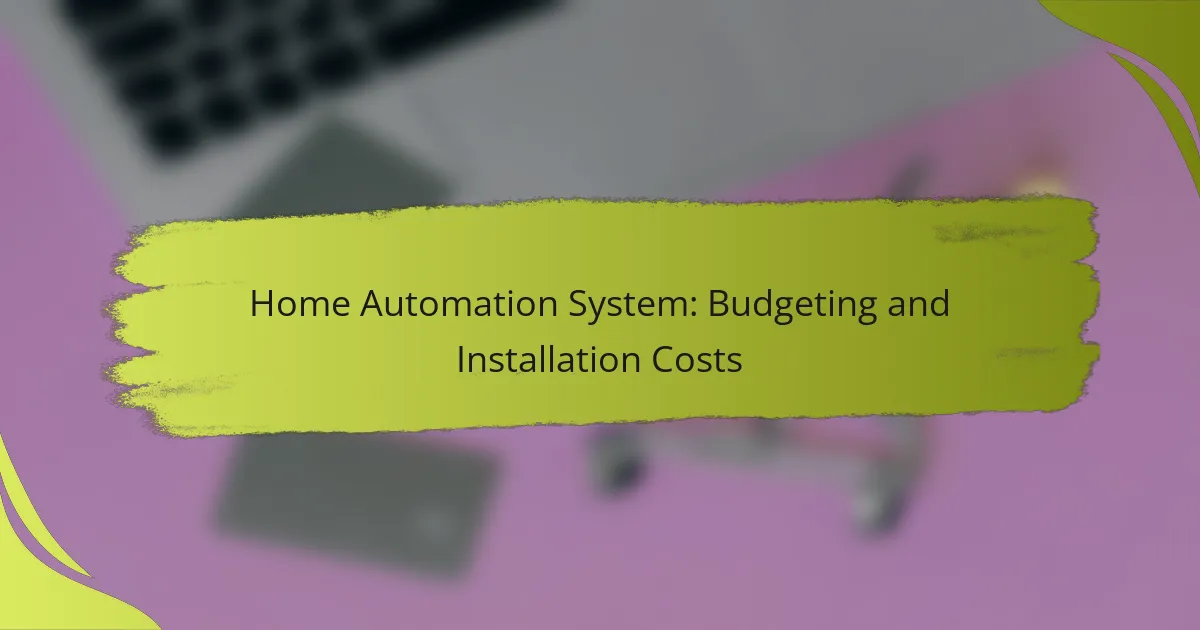Home automation systems offer a range of features and complexities, with prices in India starting around ₹15,000 for basic setups and potentially exceeding ₹1,50,000 for advanced options. Installation costs can also vary widely, influenced by the complexity of the system and whether you choose professional installation or a DIY approach. Effective budgeting involves assessing your specific needs and exploring financing options to manage these expenses efficiently.
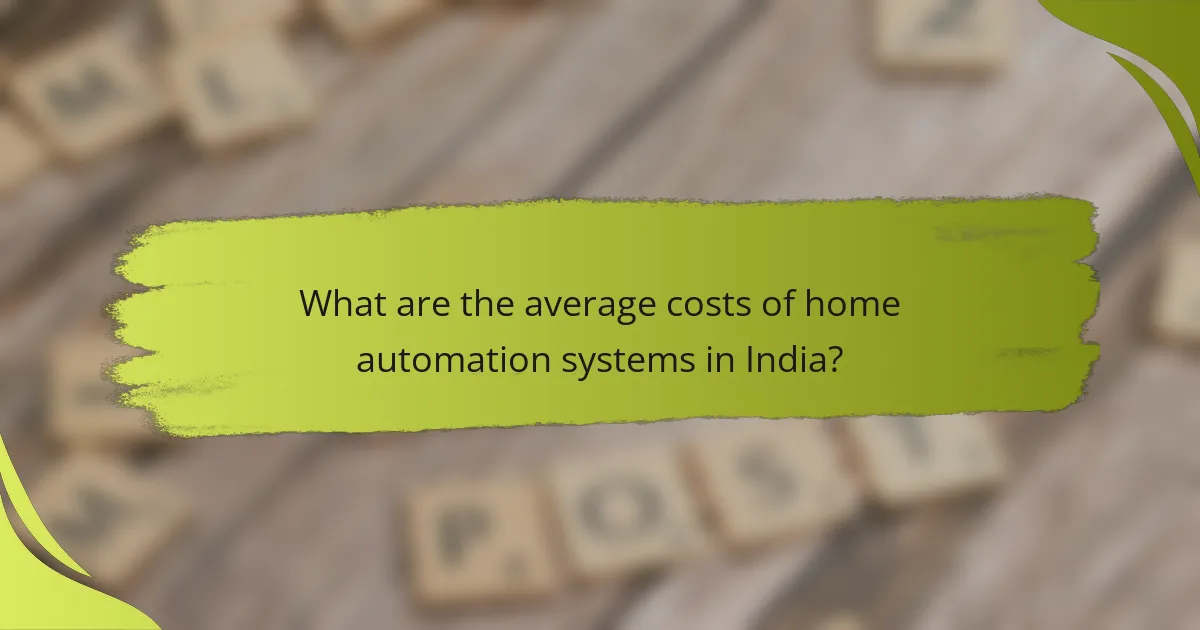
What are the average costs of home automation systems in India?
The average costs of home automation systems in India can vary significantly based on the complexity and features of the system. Basic setups typically start around ₹15,000, while more advanced systems can reach up to ₹1,50,000 or more, depending on the brand and functionalities included.
Basic systems cost between ₹15,000 to ₹30,000
Basic home automation systems generally include essential features such as smart lighting, simple security systems, and basic appliance control. These systems are ideal for homeowners looking to dip their toes into automation without a hefty investment.
For example, a basic smart lighting system may cost around ₹15,000, while adding a few smart plugs and a security camera could bring the total closer to ₹30,000. These systems often come with user-friendly apps for easy control.
Advanced systems range from ₹50,000 to ₹1,50,000
Advanced home automation systems offer a comprehensive suite of features, including full home security, climate control, and integration with various smart devices. These systems are designed for users who want a fully connected home experience.
Prices for these systems typically start at ₹50,000 and can go up to ₹1,50,000 or more, depending on the number of devices and the complexity of the installation. For instance, a complete smart home setup that includes automated blinds, advanced security features, and smart HVAC control could easily fall into this higher price range.
Factors influencing costs include brand and features
Several factors can influence the costs of home automation systems, including the brand reputation and the specific features offered. Premium brands often charge more due to their reliability and advanced technology.
Additionally, features such as voice control, compatibility with other smart devices, and installation complexity can significantly affect the overall price. It’s essential to assess your needs and budget before choosing a system to ensure you get the best value for your investment.

What are the installation costs for home automation systems?
The installation costs for home automation systems can vary significantly based on the complexity of the setup and whether you choose professional help or opt for a DIY approach. Generally, you can expect to spend anywhere from a few thousand to tens of thousands of rupees depending on your specific needs and preferences.
Professional installation fees range from ₹5,000 to ₹20,000
Hiring a professional for home automation installation typically costs between ₹5,000 and ₹20,000. This range depends on factors such as the size of your home, the number of devices being installed, and the complexity of the system.
When considering professional installation, it’s essential to factor in the expertise and warranty that come with it. Professionals can ensure that everything is set up correctly and functioning optimally, which can save you time and potential headaches later.
DIY installation can save costs but requires technical skills
Choosing to install a home automation system yourself can significantly reduce costs, often bringing expenses down to just the price of the equipment. However, this approach requires a certain level of technical skill and comfort with technology.
Before embarking on a DIY installation, assess your capabilities and the complexity of the system. Many manufacturers provide detailed guides and online resources, but be prepared for troubleshooting if issues arise. Ensure you have the necessary tools and a clear plan to avoid common pitfalls, such as improper wiring or connectivity issues.
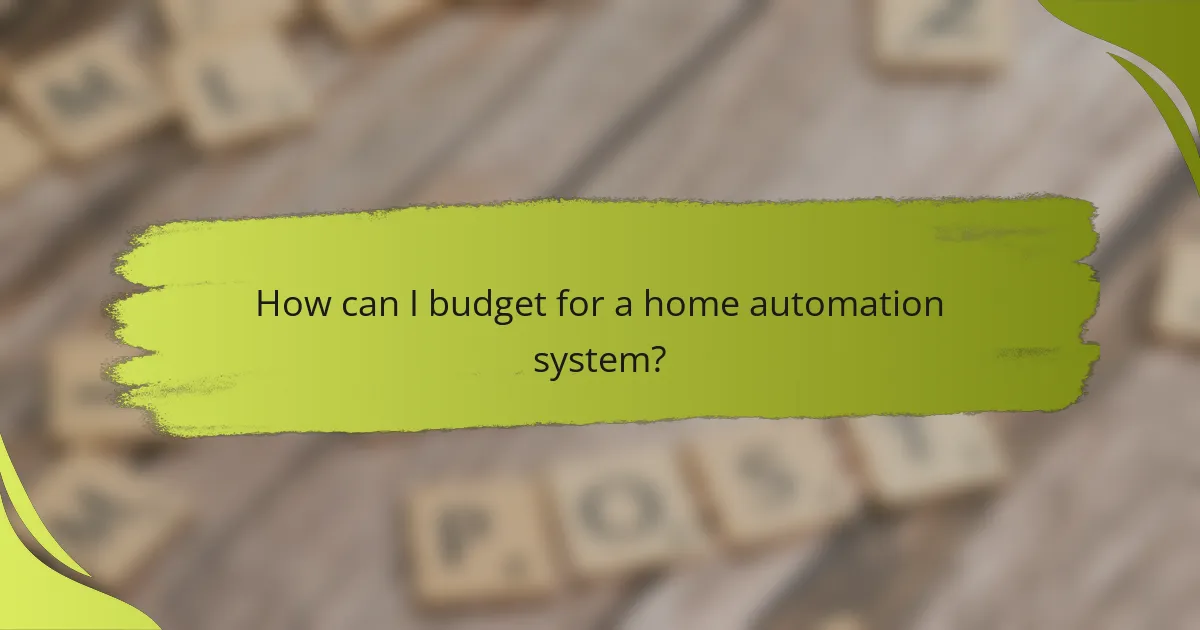
How can I budget for a home automation system?
Budgeting for a home automation system involves assessing your needs, understanding costs, and planning for future savings. Start by determining which features are essential for your lifestyle and explore financing options to manage expenses effectively.
Identify essential features to prioritize
Begin by listing the features that matter most to you, such as smart lighting, security systems, or climate control. Prioritizing these elements helps focus your budget on what will enhance your daily life the most. For instance, a smart thermostat can improve comfort and efficiency, while smart locks enhance security.
Consider the integration capabilities of your chosen devices. Some systems work better together, which can save you money in the long run by reducing compatibility issues. Research brands that offer comprehensive solutions to avoid extra costs later.
Consider long-term savings on energy bills
Investing in energy-efficient smart devices can lead to significant savings on utility bills over time. For example, smart thermostats can reduce heating and cooling costs by optimizing usage patterns. Homeowners often see reductions of 10-30% on their energy bills with these systems.
Additionally, smart lighting solutions that use LED technology consume less power than traditional bulbs. By calculating potential savings, you can justify higher upfront costs as a wise long-term investment.
Explore financing options and payment plans
Many retailers and service providers offer financing options that allow you to spread the cost of your home automation system over time. Look for zero-interest plans or promotional financing that can make your purchase more manageable. This can be particularly useful for larger installations.
Additionally, consider using a home equity line of credit (HELOC) if you own your home. This option can provide lower interest rates compared to personal loans, making it easier to fund your automation project. Always compare terms and ensure you understand the total cost of financing before committing.
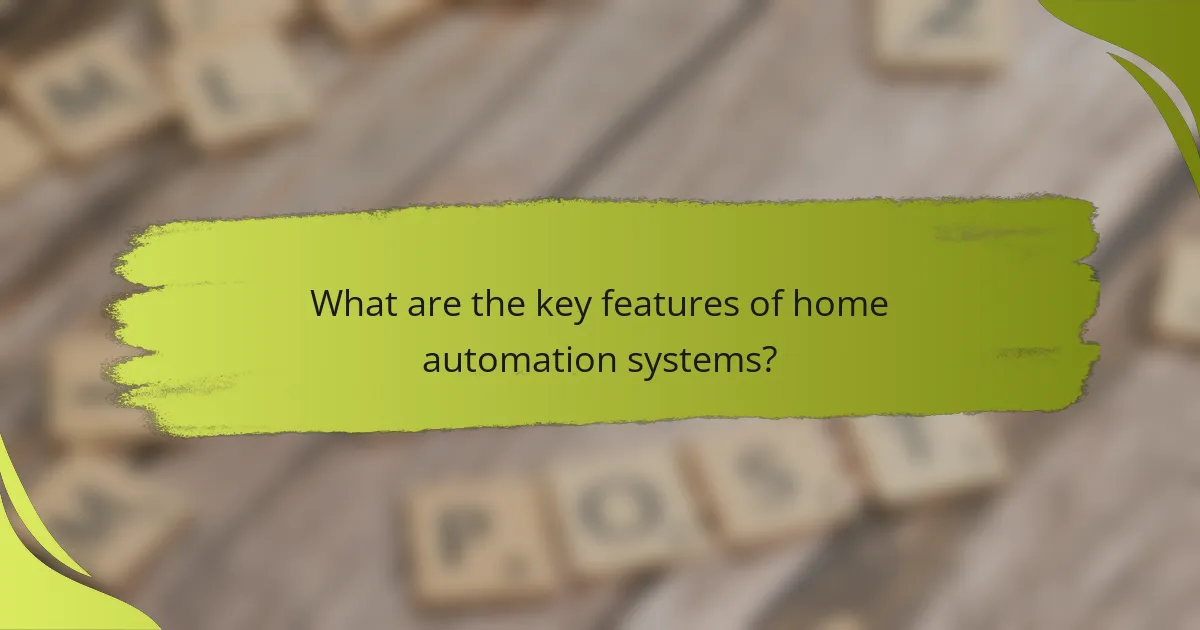
What are the key features of home automation systems?
Home automation systems enhance convenience, security, and energy efficiency through interconnected devices. Key features include smart lighting, security integration, and climate control, allowing users to manage their home environment remotely or automatically.
Smart lighting control
Smart lighting control allows homeowners to adjust lighting settings via smartphone apps or voice commands. This feature can include dimming options, color changes, and scheduling, enabling users to create the perfect ambiance for any occasion.
When considering smart lighting, look for systems compatible with existing fixtures and those that offer energy-saving capabilities. Popular options include LED bulbs that can be controlled remotely, often costing between $10 to $50 per bulb.
Security and surveillance integration
Security and surveillance integration provides real-time monitoring and alerts through cameras, motion sensors, and smart locks. Users can receive notifications on their devices when unusual activity is detected, enhancing home security.
Investing in a comprehensive security system may involve upfront costs ranging from a few hundred to several thousand dollars, depending on the number of devices and features. Ensure the system complies with local regulations and offers reliable data encryption for privacy protection.
Climate control systems
Climate control systems allow users to manage heating, ventilation, and air conditioning (HVAC) remotely. Smart thermostats can learn user preferences and optimize energy use, often resulting in savings on utility bills.
When selecting a climate control system, consider models that integrate with existing HVAC systems and offer features like geofencing and energy usage reports. Prices for smart thermostats typically range from $100 to $300, with potential energy savings of 10-20% on heating and cooling costs.

What brands offer home automation systems in India?
Several brands provide home automation systems in India, each with unique features and capabilities. Popular options include Philips Hue for lighting, Amazon Echo for voice control, and Google Nest for climate management.
Philips Hue for smart lighting
Philips Hue is a leading brand for smart lighting solutions, allowing users to control their home lighting remotely via a smartphone app or voice commands. The system is compatible with various smart home platforms and offers a range of bulbs and fixtures.
When considering Philips Hue, think about the types of bulbs you need, such as LED or color-changing options, and the number of fixtures to be equipped. Prices typically range from INR 1,000 to INR 5,000 per bulb, depending on the features.
Amazon Echo for voice control
Amazon Echo devices serve as central hubs for voice control in home automation systems. With Alexa, users can manage various smart devices, play music, and access information using voice commands.
To integrate Amazon Echo into your home, ensure compatibility with your existing devices. The Echo Dot, for instance, is an affordable entry point, usually priced around INR 3,000 to INR 5,000. Consider the placement of the device for optimal voice recognition.
Google Nest for climate control
Google Nest products, including thermostats and smoke detectors, focus on climate control and safety. These devices learn user preferences and can be controlled remotely, helping to optimize energy usage.
Investing in a Google Nest thermostat can save on energy bills, with prices generally between INR 15,000 and INR 25,000. Ensure your HVAC system is compatible and consider professional installation for best results.
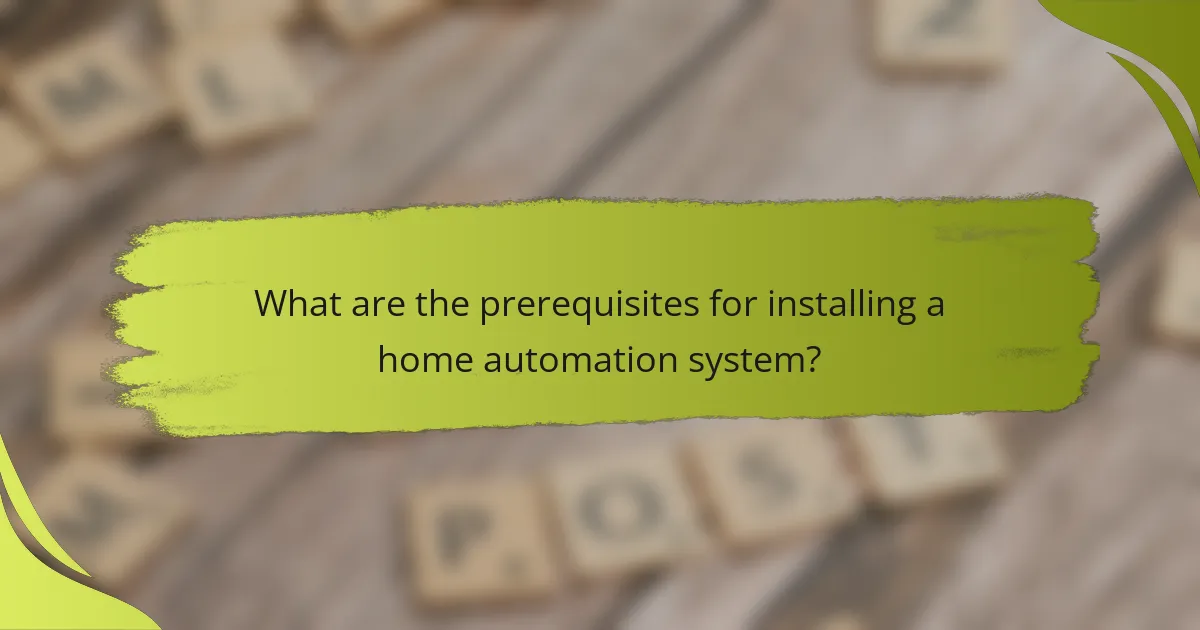
What are the prerequisites for installing a home automation system?
Before installing a home automation system, ensure you have a reliable Wi-Fi network and check the compatibility of your existing devices. These factors are crucial for seamless integration and functionality of your smart home setup.
Stable Wi-Fi network is essential
A stable Wi-Fi network is the backbone of any home automation system. Most smart devices rely on a strong internet connection to communicate effectively, so consider upgrading your router or adding extenders if you experience weak signals in certain areas of your home.
When planning your installation, aim for a Wi-Fi speed of at least 25 Mbps for optimal performance. This ensures that multiple devices can operate simultaneously without lag, especially when streaming video or using voice commands.
Compatibility with existing devices
Before purchasing new smart devices, check their compatibility with your current technology. Many home automation systems use specific protocols like Zigbee, Z-Wave, or Wi-Fi, so ensure your devices can communicate with each other effectively.
It’s also wise to consider ecosystems such as Google Home, Amazon Alexa, or Apple HomeKit, as these platforms offer varying levels of device support. Researching compatibility can save you from costly mistakes and ensure a smoother installation process.
